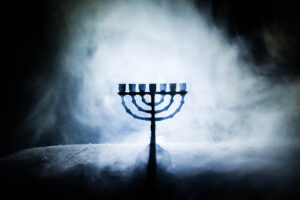Parshat Naso – The Service of Joy
This week’s Parsha, at least in the Diaspora, is Parshat Naso. It is the longest Parsha of the Torah, which is befitting after receiving the Torah on Shavuot, a new beginning, which is marked by the biggest Parsha of the year, and also one of the most powerful sections of the Zohar of the year, the Idra Rabba, and also one of the longest sections of the Midrash Rabbah of the year also.
In the Parsha, we delve into the profound concept of joy, Simcha, and its significance in performing mitzvot. The Parsha offers a detailed account of the work divisions among the Levites and their essential role in the service of the Tabernacle. Among the various duties assigned to them, we encounter a specific verse that sheds light on the importance of infusing joy into our observance of mitzvot. This verse states “Avodat Avodah” (BaMidbar 4:47), emphasizing the idea that the Levites carried out their tasks with a sense of joy and delight. Rashi explains that the Levites employed music and song to enhance the sacrificial service, connecting joy to the performance of mitzvot. This elucidates the notion that the experience of joy is an integral part of fulfilling commandments and engaging in spiritual practices.
Rabbeinu Bachyey on the Torah has a very, very extensive piece on this wording, “Avodat Avodah”, the service of another service. He shows that this doesn’t only apply to the service of the work of the Leviim in the Temple for the sake of the Korbanot done by the Kohanim, which is how Rashi interprets based on the sages. This word Avodah also refers to every mitzvah in the Torah. Every mitzvah is called an Avodah service. But here – in the expression of “Avodah Avodah” – there’s a hint to another service behind every other service you. What’s the idea?
The mitzvah connects you to Hashem and it’s a service. To put on your tefillin in the morning is a service. To say Kirat Shema twice a day is a service. To give tzedakah is a service. Learning Torah is a service. And just like in the case of the Avodat Avodah of the Leviim, it was the accompaniment of singing and playing music for the sake of another mitzvah, which was in that case the sacrifices of the Kohanim, so too does this apply for every mitzvah. There’s Avodah, e.g. putting on tefillin, doing Yom Kippur, doing Shabbat, tzedakah, Talmud Torah etc.. However, if you do this mitzvah with joy, which is like the second Avodah of the Leviim, then that’s considered another mitzvah. If you put on tefillin, you get a mitzvah. You put on tefillin with joy, it’s a hidden second mitzvah within the mitzvah of the tefillin. Thus, if you do it with Simcha, you get another reward. It’s another level, another dimension.
The idea of joy in mitzvah observance is further explored in the teachings of Rebbe Nachman. The Rebbe suggests that by engaging in these acts of devotion with a joyful heart, we not only fulfill our obligations but also cultivate a deeper connection with God. The true essence of joy lies in our ability to perform mitzvot wholeheartedly, recognizing that each act is an opportunity for spiritual growth and elevation.
Simcha has the power to elevate and sanctify the physical aspects of our lives. By consciously attaching a mitzvah to our everyday experiences, we can transcend the confines of the material realm and infuse holiness into even the most mundane activities. Reb Noson teaches that joy has the potential to bring personal redemption. When we approach life with a genuine sense of joy and enthusiasm, we open doors and create opportunities for positive change and transformation.
An inspiring anecdote involving two great Chassidic masters and brothers, Rabbi Elimelech of Lizhensk and Rabbi Zushe of Anipoli, exemplifies the problem-solving power of joy:
There was a time in their life that they went traveling incognito, undercover, no one knew who they were. They did this purposely, as many tzaddikim went on a self-imposed exile. They came to a village where there was a nighttime curfew at 9pm, and they arrived at quarter to nine. It was late, and they didn’t have enough time to set up their lodgings. By 9 p.m. they found themselves still on the street. The police saw them and arrested them. No one knew who they were, so there was no one to defend them.
They were put in a cell – a giant room with mattresses all around, and in the middle there was the pot of relief, the toilet. The halacha states that in the presence of the stench and the toilet. You cannot daven.Rabbi Elimelech was very sad and very broken. Rabbi Zusha, the older brother, was always the happier one. He saw his brother was broken. He said to him: “why are you so sad, my brother? What’s wrong?” Rabbi Elimelech said: I can’t daven, and we have to do the Evening Shema. I can’t even open my mouth now for any words of holiness!”.
Rabbi Zusha said: “Just the opposite, my tzaddik brother who’s never missed Arvit in his entire life. Hashem now wants you to fill the mitzvah like this. The halacha says that when you’re in such a situation, what do you do? You have to say in your heart – Master of the Universe, I want to do your Will but the situation doesn’t allow me to do so. I can’t. So let it be considered, as if I did this mitzvah. And halacha says, you are rewarded as if you did the mitzvah, because you did your best.”
They both got excited about this, and they started dancing at the opportunity they had to do the mitzvah like this. All the inmates, Jews, non-Jews, criminals, innocent people were just looking at them. They started to grab everybody’s hands and they made a giant dance circle around the toilet. The warden of the jail heard the singing and the noise and asked, “What’s all this noise? They told him: “it’s because of the toilet”. He said, “Oh, really? Because of the toilet, they’re happy? I’ll fix that”. He opened the cell and ordered to have the toilet removed. They removed the toilet and after five minutes past the stench got out and they were able to daven.
Despite finding themselves imprisoned unjustly, these two righteous individuals managed to find joy in their dire circumstances. Their radiant spirits and unwavering trust in God’s plan allowed them to transcend the physical limitations of their confinement. This remarkable story serves as a powerful testament to the profound impact of joy on our spiritual well-being and the potential it holds for altering our external circumstances.
The Rebbe suggests that by engaging in acts of devotion with a joyful heart, we not only fulfill our obligations but also cultivate a deeper connection with God
The connection between joy and mitzvah observance extends beyond personal transformation. When we perform mitzvot with joy, we also have a positive impact on those around us. A mitzvah performed with a joyful heart has the power to inspire others and attract divine blessings. Joy is contagious, and when we radiate joy in our actions, we uplift the spirits of those who witness our dedication and enthusiasm. By infusing joy into our observance of mitzvot, we create an environment that encourages others to join us in fulfilling God’s commandments and experiencing the profound joy that comes with it.
Furthermore, joy in mitzvah observance allows us to strengthen our relationship with others. When we approach our interactions with a joyful heart, we cultivate an atmosphere of warmth, love, and unity. Joy serves as a bridge that connects us to our fellow human beings, fostering meaningful connections and building strong communities. It is through joy that we can create an environment where individuals feel seen, valued, and supported, promoting a sense of belonging and togetherness.
While joy is a fundamental aspect of mitzvah observance, it is essential to acknowledge that it is not always easy to maintain a state of constant joy. Life is filled with challenges, setbacks, and moments of pain and sadness. However, even in the face of adversity, the Jewish tradition teaches us to strive for joy. This does not mean denying or suppressing our emotions but rather finding a way to navigate through them with a sense of faith and trust. Rebbe Nachman encourages us to look for the hidden joy within every situation, recognizing that even the most challenging experiences can lead to growth and spiritual enlightenment.
In conclusion, Simcha, or joy, is not merely an emotion but an essential component of performing mitzvot and engaging in spiritual practices. It enhances our connection with the Divine and has the power to transform our lives from within. By cultivating joy in our hearts and infusing it into our observance of mitzvot, we unlock the potential for personal growth, spiritual elevation, and even miraculous outcomes. May we strive to approach every mitzvah with a joyful heart, embracing the transformative power of Simcha in our lives.
Shabbat Shalom
- 0 comment























